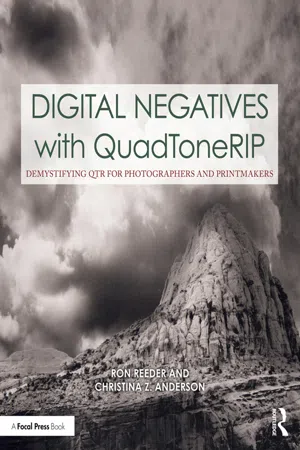
Digital Negatives with QuadToneRIP
Demystifying QTR for Photographers and Printmakers
Ron Reeder, Christina Anderson
- 296 páginas
- English
- ePUB (apto para móviles)
- Disponible en iOS y Android
Digital Negatives with QuadToneRIP
Demystifying QTR for Photographers and Printmakers
Ron Reeder, Christina Anderson
Información del libro
Digital Negatives with QuadToneRIP is a text that fully explores how the QuadToneRIP printer driver can be used to make expert digital negatives. The book takes a comprehensive, Òunder-the-hoodÓ look at how Roy Harrington's QTR printer driver can be adapted for use by artists in several different creative practice areas. The text is written from the Mac/Photoshop point of view.
The book is divided into three parts. Part One is a step-by-step how-to section that will appeal to both beginning and more advanced practitioners. Part One includes quickstart guides or summary sheets for beginning students who want to jump into using QTR before understanding all of its functional components. Part Two addresses dimroom, darkroom, and printmaking practices, walking the reader through brief workflows from negative to print for lithium palladium, gum bichromate, cyanotype, salted paper, kallitype, silver gelatin and polymer photogravure, with a sample profile for each. It also includes an introduction to a new software iteration of QTR: QuickCurve-DN (QCDN). Part Three is devoted to contemporary practitioners who explain how they use QTR in their creative practice.
The book includes:
-
- A list of supplies and software needed
-
- A summary QTR glossary with a simple explanation of how each function works
-
- A sample walk-through to create a QTR profile from start to finish
-
- How to linearize profiles with simple to more exacting tools
-
- A visual guide to modifying functions
-
- Quickstart guides for many of the workflows
-
- Instructions for crafting monochrome, duotone, tricolor, and quadcolor negatives
-
- Instructions for using QTR to print silver gelatin in the darkroom
-
- Instructions for using QTR to print alternative processes in the dimroom
-
- Instructions for using QTR to print polymer photogravure in the printmaking room
-
- Introductory chapter to QuickCurve-DN software
-
- Troubleshooting common QTR problems
-
- Generic starter profiles for processes discussed
-
- Contemporary artists: their work and QTR process.
Learning how to craft expert digital negatives can be a bit overwhelming at the outset. Digital Negatives with QuadToneRIP makes the process as user-friendly as possible. Like other books in the series, Digital Negatives with QuadToneRIP is thoroughly comprehensive, accessible to different levels of learner, and illustrative of the contemporary arts.
Preguntas frecuentes
Información
PART ONE
QuadToneRIP

Chapter 1
Getting Started


Why QTR?
- QTR gives the artist complete control over the printer’s inks. It tells the printer how much of each ink to use and what color for every tone in the image. It is arguably the most flexible method with which to make negatives for any photo printing process.
- QTR has been demonstrated to produce high quality negatives for any contact printing purpose. This includes printing in the silver gelatin darkroom, where using traditional curves in Photoshop often leads to posterization (an uneven, sometimes jagged, sometimes flat, stairstepping of tones from one to another) in the image.
- This approach utilizes commonly available Epson printers and inksets (the Epson P800 and K3 inkset are illustrated in this book). Thus, once you are done making negatives the printer is instantly available for normal, full color, inkjet printing.
- To be honest, for the most of us who are not adept computer programmers, QTR can be a bit of a steep learning curve, but I think it is worth the effort and hope this book will help you get past that barrier.